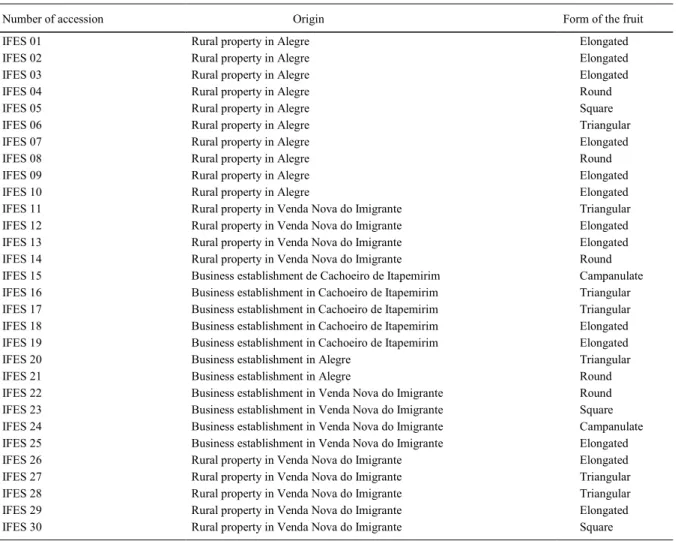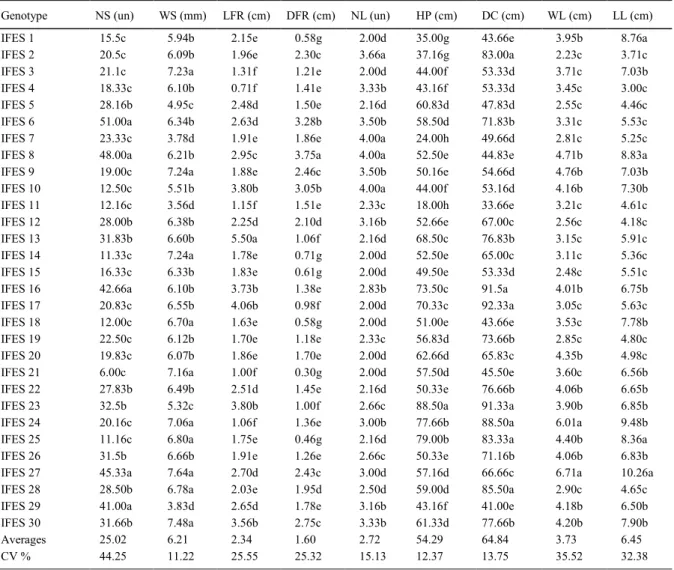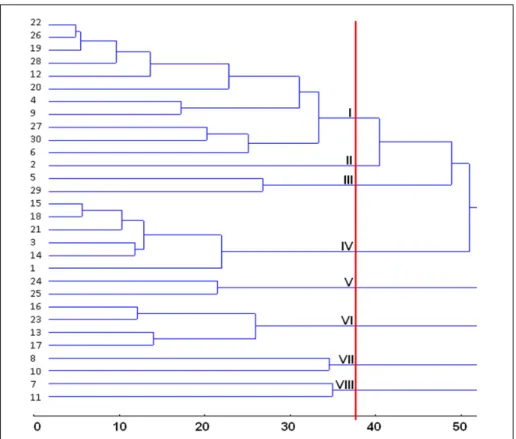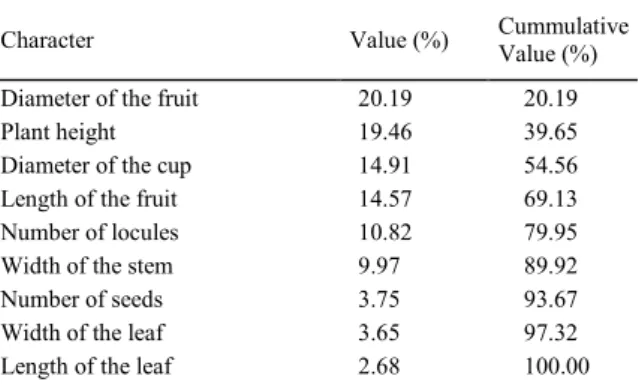Morphological characterization and analysis of genetic variability among pepper accessions. 1151
Morphological characterization and analysis of genetic
variability among pepper accessions
Caracterização morfológica e análise da variabilidade genética entre acessos de pimenta
Paola Alvares BianchiI Iris Petronilia DutraI Monique Moreira MoulinI* Jardel Oliveira SantosII Alexandre Cristiano Santos JúniorI
ISSN 1678-4596
ABSTRACT
The peppers of the genus Capsicum have economic potential and elevated genetic variability. The objective of the study was to characterize morpho-agronomically and estimate the genetic divergence among pepper accessions of the active germplasm bank of Capsicum of the Instituto Federal do Espírito Santo, Campus Alegre. Thirty accessions were characterized based on ten morphological descriptors being the experimental design completely randomized, with six repetitions. Genetic diversity among the accessions was estimated by the Tocher grouping method as a measurement of dissimilarity and formed eight groups. The Singh method, used to estimate the relative contribution of each character in the expression of genetic divergence, indicated that the diameter of the produce (20.19%) and the height of the plant (19.46%) were the ones to contribute most to the total divergence (39.65%) among the accessions of pepper being studied. The study evidenced the existence of high genetic variability among the accessions of C. annuum collected in the south region of the state of Espírito Santo. No correlation was detected between the genetic distance and location of collections.
Key words:Capsicum, phenotypic divergence,genetic resources, germplasm characterization.
RESUMO
As pimentas do gênero Capsicum possuem potencial econômico e elevada variabilidade genética. Objetivou-se realizar a caracterização morfoagronômica e estimar a divergência genética entre acessos de pimenta do banco ativo de germoplasma de Capsicum do Instituto Federal do Espírito Santo, Campus de Alegre. Foram caracterizados trinta acessos com base em dez descritores morfológicos, sendo o delineamento experimental inteiramente casualizado, com seis repetições. A divergência genética entre os acessos foi estimada pelo método de agrupamento de Tocher, como medida de dissimilaridade, formando-se oito grupos. O método de Singh, utilizado para estimar a contribuição
relativa de cada caráter na expressão da divergência genética, indicou que o diâmetro do fruto (20,19%) e a altura da planta (19,46%) foram os que mais contribuíram para a divergência total (39,65%) entre os acessos de pimenta avaliados. O estudo realizado evidencia a existência de alta variabilidade genética entre os acessos de C. annuum coletados no Sul do Estado do Espírito Santo. Não foi detectada correlação entre a distância genética e os locais de coleta.
Palavras-chave: Capsicum, divergência fenotípica, recursos genéticos, caracterização de germoplasma.
INTRODUCTION
The genus Capsicumincludes the peppers and chilies, has a great nutritional and economic value, and is widely grown in the whole world (HILL et al., 2013). Brazil is a diversity center for the genus, housing domesticated, semi-domesticated and wild species (MOSCONE et al., 2007).
The species of the Capsicum genus have great variability in its main morphological characters, such as form, size, color and position of flowers and fruits. Pepper plants are preferably autogamous, diploid with 2n=2x=24 or 2n=2x=26 chromosomes and have pungency as a marking characteristic, which is attributed to the alkaloid substances, more specifically the capsaicinoids (MOSCONE et al., 2007).
Pepper fruits are present in the cuisine of most countries and the wide diversity of the genus results in multiple uses, as dry fruits for consumption
IInstituto Federal do Espírito Santo (IFES), 29500-000, Alegre, ES, Brasil. E-mail: mmmoulin@ifes.edu.br. *Corresponding author. IIUniversidade Federal do Maranhão (UFMA), Chapadinha, MA, Brasil.
in natura, or dried for the processing in powder or extracts (ALBRECHT et al., 2012). Growth of pepper is important both for profitability, mainly when the producer adds value to the product and for its social importance in high labor employment (RÊGO et al., 2011). Knowledge of the genetic diversity present among the accessions has great importance for the management and use of the germplasm in the genetic improvement of species. Variability presented by the individuals constitutes the genetic resources, whose characterization and evaluation are essential for plant breeding projects (SUDRÉ et al., 2005). According to NEITZKE et al. (2010) the increase of these activities must be a priority among the strategies of approach to and management of the genetic resources in Brazil.
For the peppers there is little availability of scientific information on its morphology and other characters that give quality to produce, evidencing the lack of improved varieties. Many species of the Capsicum genus, are still poorly worked, from genetic improvement point of view (RODRIGUES et al., 2012).
GONÇALVES et al. (2008) decribed that the characterization can be morphological, phenotipical reproductive, biochemical, cytogenetic or molecular. In this context,studies with morphological markers make significant contributions to the understanding of the genetic diversity. There is a need to study the agrobiodiversity and best use of the genotype’s potential, so this research had the objective of characterizing, by means of morphological descriptors, 30 accessions of the active germplasm bank of Capsicum of the Instituto Federal do Espírito Santo, Campus de Alegre.
MATERIALS AND METHODS
The fruits of pepper were collected in rural properties, markets and fairs located in the south regions of the Espírito Santo State, in the municipalities of Alegre, Cachoeiro de Itapemirim and Venda Nova do Imigrante, totaling 30 accessions. Seeds of the collected fruit were planted in 5L pots and later, after 90 days of plantation, the morphological characterization of the accessions was carried out. The plants were conducted under field conditions following the recommendations of FILGUEIRA (2008) for pepper culture.
Accessions were characterized by the following morpho-agronomical descriptors: form of fruits (FRF), plant height (PH), diameter of the cup (DC), fruit length (FRL), fruit diameter (FRD),
number of seeds per fruit (NS), number of locules per fruit (NL), stem width (SW), leaf width (LW) and leaf length (LL).
For the morphological characterization, six repetitions of each accession were used; totaling 180 plants grown in the nursery of the Instituto Federal do Espírito Santo, Campus Alegre. The experimental design for the analysis of the variances of each character was completely randomized. For the comparison among the averages of the accessions the SCOTT-KNOTT (1974) grouping criteria at 1% probability was used.
In the multivariate analysis, the genetic divergence among the accessions was determined by the Tocher (RAO, 1952) method. The identification of the importance of the characters was done based on the Singh (SINGH, 1981) method.
The statistical-genetic analyses were carried out with the aid of the Genes program (CRUZ, 2008). Grouping of accessions was obtained by the Unweighted Paired Group Method using Arithmetic averages (UPGMA) method.
RESULTS AND DISCUSSION
A great phenotypic variability for the ten characters studied was evidenced. Taking into account the format standards (Table 1) and the morphological characteristics assessed (number of seeds, stem width, fruit length, fruit diameter, number of locules, height of the plant, diameter of the cup, width of the leaf and length of the leaf) it was observed that the pepper accessions present great variation. Measurements that presented significant differences among them were obtained in all the characters (Table 2), being these grouped by the Scott e Knott test (SCOTT & KNOTT, 1974) at a level of significance of 1% probability. Other studies on the variability and genetic parameters in Capsicum,using morphological markers are described in the literature (BENTO et al., 2007; FINGER et al., 2010; NEITZKE et al., 2010; RÊGO et al., 2011; DOMENICO et al., 2012; SILVA NETO et al., 2014).
number of classes were: length and diameter of the fruit. Diverging results were obtained by NEITZKE et al. (2010) who described a greater number of classes for the length of the fruit character and smaller for plant height. SILVA NETO et al. (2014) confirmed that the characteristics that present greater variability were diameter of the stem and diameter of the cup with thirteen and eight groups respectively.
As for the variation coefficient (CV) a maximum value of 44,25 was obtained for the number of seeds character and a minimum value of 11,22 for diameter of the stem, being these considered rather satisfactory for the descriptors used. Results obtained in this for the CV were more favorable than those obtained in other studies with pepper (BENTO et al., 2007; NEITZKE et al., 2010; DOMENICO et al., 2012), which evidences a great genetic variability of the genotypes studied.
For the number of seeds (NS), the maximum and minimum of the averages were 51 seeds for the IFES 6 accession and six for the IFES 21 accession respectively, being the general average 25.02 (Table 2). RÊGO et al. (2011) obtained higher average values for the number of seeds per fruit, varying between 8 and 144 seeds; however, authors characterized accessions previously selected in higher numbers than those of this study totaling 69 which may explain said higher variation obtained.
The characteristic width of the stem (SW) had a maximum average of 0.76mm for the IFES 27 accession and a minimum of 0.36mm the IFES 11, with a general average of 0.62mm. SILVA NETO et al. (2014) observed similar values when characterizing
C. annuum plants of ornamental potential of a F2 generation. According to the same authors, thicker stems are of interest to the improvement since plants Table 1 - List of 30 pepper accessions originating from the active germplasm bank of the Instituto Federal do Espírito Santo, Campus
Alegre, including the place of origin and the fruit form.
Number of accession Origin Form of the fruit
IFES 01 Rural property in Alegre Elongated
IFES 02 Rural property in Alegre Elongated
IFES 03 Rural property in Alegre Elongated
IFES 04 Rural property in Alegre Round
IFES 05 Rural property in Alegre Square
IFES 06 Rural property in Alegre Triangular
IFES 07 Rural property in Alegre Elongated
IFES 08 Rural property in Alegre Round
IFES 09 Rural property in Alegre Elongated
IFES 10 Rural property in Alegre Elongated
IFES 11 Rural property in Venda Nova do Imigrante Triangular
IFES 12 Rural property in Venda Nova do Imigrante Elongated
IFES 13 Rural property in Venda Nova do Imigrante Elongated
IFES 14 Rural property in Venda Nova do Imigrante Round
IFES 15 Business establishment de Cachoeiro de Itapemirim Campanulate IFES 16 Business establishment in Cachoeiro de Itapemirim Triangular IFES 17 Business establishment in Cachoeiro de Itapemirim Triangular IFES 18 Business establishment in Cachoeiro de Itapemirim Elongated IFES 19 Business establishment in Cachoeiro de Itapemirim Elongated
IFES 20 Business establishment in Alegre Triangular
IFES 21 Business establishment in Alegre Round
IFES 22 Business establishment in Venda Nova do Imigrante Round IFES 23 Business establishment in Venda Nova do Imigrante Square IFES 24 Business establishment in Venda Nova do Imigrante Campanulate IFES 25 Business establishment in Venda Nova do Imigrante Elongated
IFES 26 Rural property in Venda Nova do Imigrante Elongated
IFES 27 Rural property in Venda Nova do Imigrante Triangular
IFES 28 Rural property in Venda Nova do Imigrante Triangular
IFES 29 Rural property in Venda Nova do Imigrante Elongated
with very thin stems tend to bed and lose their commercial value.
With respect to the length of the fruit (FRL), an average of 2.34cm was obtained with a maximum value of 5.5cm for the IFES 13 accession and a minimum of 0.71 for the IFES 4 accession. JARRET & BERKE (2008) observed a variation of 0.8cm to 11.4cm. DOMENICO et al. (2012) reported values of 2.1cm to 7.7cm. For the diameter of the fruit (FRD) a greater variability was detected, having seven classes been identified, with a maximum average of 3.75cm for the IFES 8 accession, and minimum of 0.3cm for the IFES
21 and general average for the character of 1.60cm. FONSECA et al. (2008) obtained averages that vary between 0.7cm and 2.5cm, while, DOMENICO et al. (2012) observed a smaller variation of 1.1cm to 2.5cm for this characteristic.
With respect to the variable number of locules (NL) a general average of 2.72 was confirmed and as expected there was low variability for this character, the fruits had between two and four locules, obtaining a maximum average of four locules for the IFES 7, IFES 8 and IFES 10 accessions. Similarly, RÊGO et al. (2011) when characterizing 69 accessions of Capsicum
reported a variation between two and four locules. Table 2 - Averages1 of the 30 accessions of pepperwith respect to nine morphological characters.
Genotype NS (un) WS (mm) LFR (cm) DFR (cm) NL (un) HP (cm) DC (cm) WL (cm) LL (cm)
IFES 1 15.5c 5.94b 2.15e 0.58g 2.00d 35.00g 43.66e 3.95b 8.76a
IFES 2 20.5c 6.09b 1.96e 2.30c 3.66a 37.16g 83.00a 2.23c 3.71c
IFES 3 21.1c 7.23a 1.31f 1.21e 2.00d 44.00f 53.33d 3.71c 7.03b
IFES 4 18.33c 6.10b 0.71f 1.41e 3.33b 43.16f 53.33d 3.45c 3.00c
IFES 5 28.16b 4.95c 2.48d 1.50e 2.16d 60.83d 47.83d 2.55c 4.46c
IFES 6 51.00a 6.34b 2.63d 3.28b 3.50b 58.50d 71.83b 3.31c 5.53c
IFES 7 23.33c 3.78d 1.91e 1.86e 4.00a 24.00h 49.66d 2.81c 5.25c
IFES 8 48.00a 6.21b 2.95c 3.75a 4.00a 52.50e 44.83e 4.71b 8.83a
IFES 9 19.00c 7.24a 1.88e 2.46c 3.50b 50.16e 54.66d 4.76b 7.03b
IFES 10 12.50c 5.51b 3.80b 3.05b 4.00a 44.00f 53.16d 4.16b 7.30b
IFES 11 12.16c 3.56d 1.15f 1.51e 2.33c 18.00h 33.66e 3.21c 4.61c
IFES 12 28.00b 6.38b 2.25d 2.10d 3.16b 52.66e 67.00c 2.56c 4.18c
IFES 13 31.83b 6.60b 5.50a 1.06f 2.16d 68.50c 76.83b 3.15c 5.91c
IFES 14 11.33c 7.24a 1.78e 0.71g 2.00d 52.50e 65.00c 3.11c 5.36c
IFES 15 16.33c 6.33b 1.83e 0.61g 2.00d 49.50e 53.33d 2.48c 5.51c
IFES 16 42.66a 6.10b 3.73b 1.38e 2.83b 73.50c 91.5a 4.01b 6.75b
IFES 17 20.83c 6.55b 4.06b 0.98f 2.00d 70.33c 92.33a 3.05c 5.63c
IFES 18 12.00c 6.70a 1.63e 0.58g 2.00d 51.00e 43.66e 3.53c 7.78b
IFES 19 22.50c 6.12b 1.70e 1.18e 2.33c 56.83d 73.66b 2.85c 4.80c
IFES 20 19.83c 6.07b 1.86e 1.70e 2.00d 62.66d 65.83c 4.35b 4.98c
IFES 21 6.00c 7.16a 1.00f 0.30g 2.00d 57.50d 45.50e 3.60c 6.56b
IFES 22 27.83b 6.49b 2.51d 1.45e 2.16d 50.33e 76.66b 4.06b 6.65b
IFES 23 32.5b 5.32c 3.80b 1.00f 2.66c 88.50a 91.33a 3.90b 6.85b
IFES 24 20.16c 7.06a 1.06f 1.36e 3.00b 77.66b 88.50a 6.01a 9.48b
IFES 25 11.16c 6.80a 1.75e 0.46g 2.16d 79.00b 83.33a 4.40b 8.36a
IFES 26 31.5b 6.66b 1.91e 1.26e 2.66c 50.33e 71.16b 4.06b 6.83b
IFES 27 45.33a 7.64a 2.70d 2.43c 3.00d 57.16d 66.66c 6.71a 10.26a
IFES 28 28.50b 6.78a 2.03e 1.95d 2.50d 59.00d 85.50a 2.90c 4.65c
IFES 29 41.00a 3.83d 2.65d 1.78e 3.16b 43.16f 41.00e 4.18b 6.50b
IFES 30 31.66b 7.48a 3.56b 2.75c 3.33b 61.33d 77.66b 4.20b 7.90b
Averages 25.02 6.21 2.34 1.60 2.72 54.29 64.84 3.73 6.45
CV % 44.25 11.22 25.55 25.32 15.13 12.37 13.75 35.52 32.38
In the determination of the plant height (PH), it was observed that the maximum and minimum values were between 18.00cm and 88.50cm, with an average of 54.29cm. The IFES 23 accession presented the highest average and the IFES 11 accession the lowest. NEITZKE et al. (2010) obtained values similar to those observed in this research, varying between 15.03cm and 78.40cm in plant height. The diameter of the cup (DC) presented a general average of 64.84cm, with the lowest average for the IFES 11 accession (33.66cm) and the for the highest IFES 17 accession (92.33cm). In the management of germplasm banks, especially in the regeneration and multiplication of the accessions stages, this character aids in the choosing of more adequate spacing with respect to the diameter of the cup of each accession (BENTO et al., 2007).
For the foliar characteristics, width (LW) and length (LL), averages of 3.73cm and 6.45cm respectively were detected. The width varied between 2.23cm and 6.71cm and the length between 3.00cm and 10.26cm. The IFES 27 accession presented
the greatest width and length, while the IFES 2 accession presented the lower averages for both plant characteristics. SILVA NETO et al. (2014) detected a variation of 1.36cm to 2.33cm for the width of the leaf, and of 2.9cm to 5.27cm for the length of the leaf. In the classification of the fruits with respect to shape (FRF), the predominant shape was the Elongated (43,33%), in addition to the occurrence of other shapes of lower proportions, triangular (23.34%), round (16.66%), square (10.00%) and campanulate (6.67%). In agreement with the results obtained, JARRET & BERKE (2008), when evaluating the accessions of C. annuum also reported predominance of the Elongated shape.
Most distant genotypes are the IFES 11 and IFES 23 accessions, with a distance of 162.48, while the IFES 22 and IFES 26 accessions were considered the closest with a distance of 3.60. The grouping of the genotypes by means of the Tocher method resulted in the formation of eight groups (Figure 1). Group I holds eleven accessions, being that the largest group
Figure 1 - Dendrogram of genetic dissimilarities obtained by the Tocher method, based on nine
(characterized for having a high number of seeds, diameter of the stem and diameter of the cup). Group II, formed by one accession, IFES 2 (was differentiated for having a smaller foliar width and length). Group III was formed by two accessions (characterized by low caliber stems, average length and diameter of the fruit and average diameter of the cup). Group IV was represented by six accessions (lower number of seeds, low values for length and diameter of the fruit and two locules were observed). In this group were placed the accessions with ornamental characteristics, small fruit with different colors.
In group V two accessions were placed (that have small dark red fruit with leaves large in length as common characteristics). Group VI, composed by four accessions (largest fruit lengths and high average height of the pepper plants). Groups VII and VIII, composed of two accessions each, grouped the fruits of greater diameter in one and plants with lower average height in the other.
In this investigation it was not possible to confirm the correlation between genetic diversity, based on the study of morphological attributes, and place of origin of the accessions given that in the same group were arranged genotypes collected in rural properties and markets of different municipalities, Alegre, Cachoeiro de Itapemirim and Venda Nova do Imigrante, in the Espírito Santo state. In agreement with this study, other studies with different oleraceous plants also described not having correlation (GONÇALVES et al., 2008; RÊGO et al., 2011; MOULIN et al., 2012).
The estimate of the relative contribution of each character in the expression of the genetic divergence, based on the Singh method (1981), indicated that the diameter of the fruit (20.19 %), followed by height of the plant (19.46%), cup diameter , (14.91%) and length of the fruit (14.57%) were the characters that most contributed to the total divergence (69.13%) among the 30 pepper accessions (Table 3).
Width and length of the leaf were the ones which least contributed, representing a percentage of 3.65% and 2.68% respectively. DOMENICO et al. (2012), working with nine accessions of C. chinense, verified that length of the fruit (24.2%) and productivity (23.8%) were the characters that most contributed to the genetic divergence. SILVA NETO et al. (2014), when characterizing a population of C. annuum, observed that diameter of the stem (68.97%) and diameter of the cup (9.22%) were the characteristics that contributed most.
CONCLUSION
The morpho-agronomic characterization was efficient in estimating the genetic diversity of accessions, evidencing great divergence and being this an important tool for improvement, providing the best knowledge and use of the accessions. All the accessions were considered different which allowed disregarding a hypothesis of duplicates.
Correlation between the genetic distance and the origin of accessions was not observed, which can be a reflection of the common practice of exchanging peppers among rural producer.
ACKOWLEDGEMENTS
To Fundação de Apoio à Pesquisa e Estudo na Área de Saúde (FAPES), for the grant of aid and scholarship
for the development of this research and to Instituto Federal do Espírito Santo (IFES) for the financial support destined to the article translation.
REFERENCES
ALBRECHT, E. et al. Genetic diversity and population structure of Capsicum baccatum genetic resources. Genetic Resources and Crop Evolution, v.59, n.7, p.517-538, 2012. Available from:
< http://link.springer.com/article/10.1007%2Fs10722-011-9700-y#page-1>. Accessed: May 22, 2015.
BENTO, C.S. et al. Descritores qualitativos e multicategóricos na
estimativa da variabilidade fenotípica entre acessos de pimentas.
Scientia Agraria (UFPR), v.8, n.3, p.147-154, 2007. Available
from: <http://ojs.c3sl.ufpr.br/ojs/index.php/agraria/article/ viewFile/8379/6661>. Accessed: Oct. 8, 2014.
CRUZ, C.D. Programa genes (versão Windows): aplicativo
computacional em genética e estatística. Viçosa: UFV, 2008.
Available from: <http://www.ufv.br/dbg/genes/genes.htm>.
Accessed: May 24, 2015.
Table 3 - Relative contribution of the agronomic characters for the genetic divergence among the 30 pepper accessions by the method proposed by SINGH (1981).
Character Value (%) CummulativeValue (%)
Diameter of the fruit 20.19 20.19
Plant height 19.46 39.65
Diameter of the cup 14.91 54.56
Length of the fruit 14.57 69.13
Number of locules 10.82 79.95
Width of the stem 9.97 89.92
Number of seeds 3.75 93.67
Width of the leaf 3.65 97.32
DOMENICO, C.I. et al. Caracterização agronômica e pungência
em pimenta de cheiro. Horticultura Brasileira, v.30, n.2,
p.466-472, 2012. Available from: <http://www.scielo.br/scielo. php?pid=S0102-05362012000300018&script=sci_arttext>. Accessed: May 22, 2015.
FILGUEIRA, F.A.R. Novo manual de olericultura: agrotecnologia moderna na produção e comercialização de hortaliças. Viçosa: UFV, 2008. 412p.
FINGER, F.L. et al. Genetic diversity of Capsicum chinensis
(Solanaceae) accessions based on molecular markers and morphological and agronomic traits. Genetics and Molecular Research, v.9, p.1852-1864, 2010. Available from: <http:// www.funpecrp.com.br/gmr/year2010/vol9-3/pdf/gmr891.pdf>. Accessed: Sept. 05, 2015.
FONSECA, R.M. et al. Morphologic characterization and genetic diversity of Capsicum chinenseJacq. accessions along the upper Rio Negro – Amazonas. Crop Breeding and Applied Biotechnology, v.8, p.187-194, 2008. Available from: <http://
www.sbmp.org.br/cbab/siscbab/uploads/c8129493-b909-2607. pdf>. Accessed: May 24, 2015.
GONÇALVES, L.S.A. et al. Divergência genética em tomate estimada por marcadores RAPD em comparação com descritores multicategóricos. Horticultura Brasileira, v.26, n.3,
p.364-370, 2008. Available from: <http://www.scielo.br/scielo.
php?pid=S0102-05362008000300014&script=sci_arttext>. Accessed: Oct. 8, 2014.
HILL, T.A. et al. Characterization of Capsicumannuum genetic diversity and population structure based on parallel polymorphism discovery with a 30K unigene pepper genechip. Plos One, v.8,
p.1-16, 2013. Available from: <http://journals.plos.org/plosone/ article?id=10.1371/journal.pone.0056200>. Accessed: May 24, 2015.
JARRET, R.L.; BERKE, T. Variation for fruit morphological characteristics in a Capsicum chinense Jacq. germplasm collection. HortScience, v.43, n.2, p.1694-1697, 2008. Available
from: <http://hortsci.ashspublications.org/content/43/6/1694.full>.
Accessed: May 22, 2015.
MOSCONE, E.A. et al. The evolution of the chili pepper (Capsicum
– Solanaceae): a cytogenetic perspective. Acta Horticulture, v.745, n 4, p.137-169, 2007.
MOULIN, M.M. et al. Collection and morphological characterization of sweet potato landraces in north of Rio de Janeiro state. Horticultura Brasileira, v.30, n.2,
p.40-51, 2012. Available from: <http://www.scielo.br/scielo. php?pid=S0102-05362012000200017&script=sci_arttext>. Accessed: Aug. 28, 2014.
NEITZKE, R.S. et al. Dissimilaridade genética entre acessos de
pimenta com potencial ornamental. Horticultura Brasileira,
v.28, n.4, p.47-53, 2010. Available from: <http://www.scielo.br/
scielo.php?script=sci_arttext&pid=S0102-05362010000100009>. Accessed: Oct. 8, 2014.
RODRIGUES, R. et al. Combining ability and heterosis for
agronomic traits in chili pepper. Horticultura Brasileira, v.30,
n.2, p.226-233, 2012. Available from: <http://www.scielo.br/pdf/
hb/v30n2/v30n2a08.pdf>. Accessed: Oct. 8, 2014.
SCOTT, A.J; KNOTT, M.A. Cluster analysis methods for grouping means in the analysis of variance. Biometrics, v.30,
p.507-512, 1974. Available from: <http://www.ime.usp.br/~abe/lista/ pdfXz71qDkDx1.pdf>. Accessed: Oct. 8, 2014.
SILVA NETO, J.J. et al. Variabilidade em população base de pimenteiras ornamentais (Capsicum annuum L.). Revista Ceres,
v.61, n.1, p.084-089, 2014. Available from: <http://www.scielo.br/
scielo.php?pid=S0034-737X2014000100011&script=sci_arttext>. Accessed: Jan. 18, 2015.
SINGH, D. The relative importance of characters affecting genetic
divergence. Indian Journal ofGenetic and Plant Breeding, v.41, p.237-245, 1981.
SUDRÉ, C.P. et al. Divergência genética entre acessos de pimenta
e pimentão utilizando técnicas multivariadas. Horticultura Brasileira, v.23, n.1, p.22-27, 2005. Available from: <http://www.
scielo.br/pdf/hb/v23n1/a05v23n1>. Accessed: May 22, 2015.
RAO, R.C. Advanced statistical methods in biometric research. New York: J, 1952. 330p.
RÊGO, E.R. et al. Morphological and chemical characterization of fruits of Capsicumspp. accessions. Horticultura Brasileira,
v.29, n.2, p.364-371, 2011. Available from: <http://www.scielo.br/



